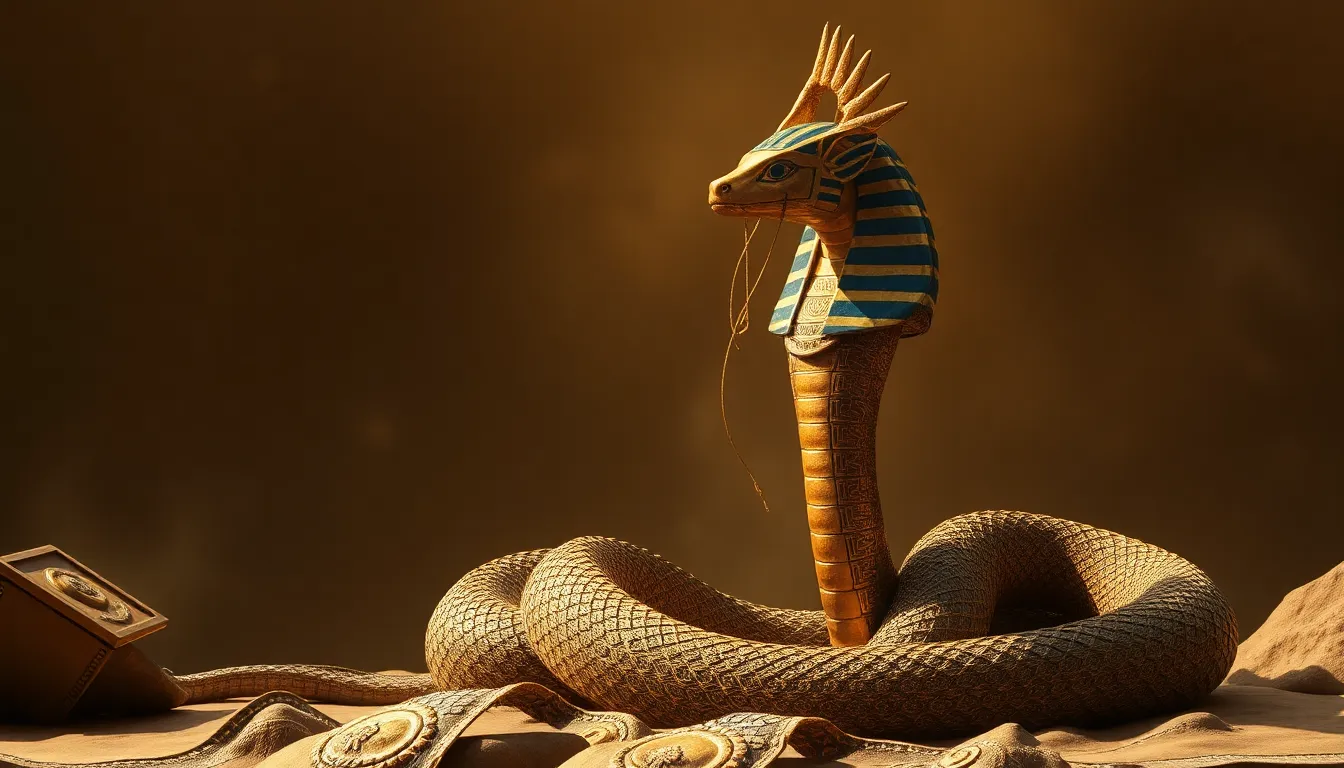The Serpent Goddess: Wadjet and Her Role in Egyptian Mythology
I. Introduction
Wadjet, the ancient Egyptian Serpent Goddess, holds a significant place in the rich tapestry of Egyptian mythology. Often depicted as a cobra, she embodies the protective and nurturing aspects of nature. Wadjet, also known as the ‘Green One’, is primarily recognized as the patron goddess of Lower Egypt, symbolizing not only the land but also the pharaoh’s divine protection. Her importance extends beyond mere representation; she is intricately woven into the beliefs and practices of ancient Egyptian society.
This article aims to explore the multifaceted role of Wadjet in Egyptian mythology, her historical evolution, iconography, and enduring legacy. By understanding her significance, we gain insight into the broader context of ancient Egyptian spirituality and culture.
II. Historical Context of Wadjet
The origins of Wadjet can be traced back to the early dynastic period of Egypt, where she was revered as a deity of fertility and the protector of the pharaohs. Ancient worship of Wadjet was prevalent in the Nile Delta, particularly in the city of Buto, which became a center for her veneration.
Over the centuries, Wadjet’s role evolved significantly, especially during the unification of Upper and Lower Egypt by Narmer (also known as Menes). As the nation merged, Wadjet became more prominent, symbolizing the unity of the two lands. Various Egyptian dynasties recognized her importance, as reflected in their art and inscriptions.
Archaeological evidence, such as temple remnants and artifacts, showcases her significance in ancient Egyptian culture. Statues, amulets, and inscriptions reveal the reverence the ancient Egyptians held for Wadjet, highlighting her status as a powerful deity.
III. Iconography and Symbolism
Wadjet is predominantly depicted as a cobra or a woman with a cobra on her head. This imagery is not only artistic but deeply symbolic. The cobra represents protection, royalty, and divinity in ancient Egyptian culture. The Uraeus, a stylized form of the cobra, became a common symbol in royal regalia, emphasizing the pharaoh’s divine right to rule.
The symbolic meanings of serpents in Egyptian culture are vast:
- Protection: Serpents were seen as guardians, warding off evil and chaos.
- Transformation: The shedding of a snake’s skin symbolized rebirth and renewal.
- Duality: Serpents embody both creation and destruction, reflecting the balance of nature.
Wadjet’s connection with other deities, such as Isis and Horus, further illustrates her significance in the pantheon. While she is often seen as a standalone goddess, her relationships with these gods enhance her role as a protector and nurturer in the mythology.
IV. Wadjet as a Protector
As a guardian of Egypt, Wadjet played a crucial role in the protection of the land and its people. She was often invoked during battles, symbolizing the strength and divine favor granted to the pharaohs. The Uraeus, which adorned the crowns of pharaohs, was believed to be a manifestation of her protective spirit, ready to strike at enemies.
The symbolism of the Uraeus in royal regalia cannot be overstated. It represented the pharaoh’s authority and connection to the divine. The cobra’s fierce gaze and readiness to attack served as a reminder of the pharaoh’s power and divine right to rule.
Wadjet’s involvement in battles was not merely symbolic; she was believed to actively participate in the protection of her people, guiding and empowering the leaders of Egypt in times of conflict.
V. Wadjet and the Concept of Duality
Wadjet embodies the concept of duality, representing both creation and destruction. This duality is central to her nature as a serpent goddess. Her association with the two lands of Egypt—Upper and Lower—further emphasizes her role as a unifying force.
The dual symbolism of serpents in mythology is profound. While they are often seen as symbols of danger and chaos, they also signify transformation and healing. In Wadjet’s case, this duality reflects her ability to protect and nurture while also representing the fierce and destructive forces of nature.
VI. Wadjet’s Influence on Other Deities
Wadjet’s relationships with other gods and goddesses are significant in understanding her role in the Egyptian pantheon. She is often associated with:
- Isis: The nurturing mother goddess, with whom Wadjet shares protective qualities.
- Horus: The sky god and protector of the pharaoh, who embodies the ideals of kingship and divine authority.
Her influence extended to the cult of Isis and Horus, where she played a supportive role in the narratives surrounding their myths. Wadjet’s protective nature complemented the attributes of these deities, emphasizing the interconnectedness of the Egyptian gods.
VII. Modern Interpretations and Cultural Impact
In contemporary spirituality and art, Wadjet has experienced a revival as people seek to reconnect with ancient wisdom. Modern interpretations often highlight her role as a protector and symbol of empowerment. Artists and spiritual practitioners draw inspiration from her imagery, using it to evoke themes of strength, protection, and renewal.
Wadjet’s significance in popular culture is also noteworthy. References to her character can be found in various forms of media, including literature, movies, and visual arts. These portrayals often emphasize her protective qualities and her status as a powerful feminine figure in mythology.
Educational efforts, including exhibitions and scholarly works, aim to raise awareness about Wadjet and her place in Egyptian mythology. By exploring her story, modern audiences can appreciate the depth and complexity of ancient Egyptian beliefs and their relevance today.
VIII. Conclusion
In summary, Wadjet’s roles as a protector, symbol of duality, and influential deity are integral to understanding her importance in Egyptian mythology. Her legacy endures in modern interpretations, reflecting a continued fascination with ancient deities and their meanings.
The enduring legacy of the Serpent Goddess serves as a reminder of the power of ancient beliefs and their ability to resonate in today’s world. Wadjet, with her fierce protection and nurturing spirit, continues to inspire and captivate the imagination of those who seek to understand the depths of ancient wisdom.




